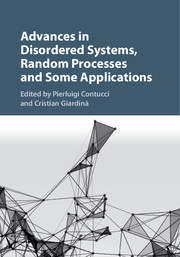Book contents
- Frontmatter
- Contents
- List of Contributors
- Preface
- 1 Topological Field Theory of Data: Mining Data Beyond Complex Networks
- 2 A Random Walk in Diffusion Phenomena and Statistical Mechanics
- 3 Legendre Structures in Statistical Mechanics for Ordered and Disordered Systems
- 4 Extrema of Log-correlated Random Variables: Principles and Examples
- 5 Scaling Limits, Brownian Loops, and Conformal Fields
- 6 The Brownian Web, the Brownian Net, and their Universality
- Index
2 - A Random Walk in Diffusion Phenomena and Statistical Mechanics
Published online by Cambridge University Press: 19 January 2017
- Frontmatter
- Contents
- List of Contributors
- Preface
- 1 Topological Field Theory of Data: Mining Data Beyond Complex Networks
- 2 A Random Walk in Diffusion Phenomena and Statistical Mechanics
- 3 Legendre Structures in Statistical Mechanics for Ordered and Disordered Systems
- 4 Extrema of Log-correlated Random Variables: Principles and Examples
- 5 Scaling Limits, Brownian Loops, and Conformal Fields
- 6 The Brownian Web, the Brownian Net, and their Universality
- Index
Summary
Introduction
In this chapter I provide a basic background on stochastic processes for diffusion problems and statistical mechanics techniques for cooperative systems. Although these fields may look quite distant, there exist many interesting, solid bridges among them. Thus, while much of the theory presented is well consolidated and already available in many wonderful reviews, what I wish to convey is just such an intrinsic connection, hoping that it may be useful for further advances and deepening. In writing this chapter I looked for a compromise between simplicity and rigor. This trade-off implies that, despite my efforts to keep the exposition as basic as possible, certain parts are still quite technical, and, while I tried to be as precise as possible, some parts are quite sloppy. Also, as I am spanning over a number of topics, the notation may change from one section to another seeking for functionality (but should be consistent within each single section).
The first part of this chapter is devoted to diffusion and, in particular, to random walks on graphs; the second part is more statistical-mechanics oriented and several models (e.g., the Gaussian model, the Curie-Weiss model) are treated and solved exploiting analogies with diffusion problems. More precisely, in Section 2.2 the phenomenology of diffusion is approached from several perspectives showing convergence to the same set of equations and behaviors. Focusing on the approach based on random walks, I discuss the emergence of anomalous diffusion and I review several analytical techniques for their investigation (e.g., generating functions and Tauberian theorems, algebraic analysis). Finally, I define and discuss the so-called Polya problem in the case of Euclidean lattices. In Section 2.3, I first provide basic definitions for graphs and their topological properties; in particular, I introduce the adjacency matrix and the Laplacian matrix, which algebraically describe the graph structure. Then, I formalize the problem of random walks on arbitrary graphs and show how the underlying topology can have dramatic effects on the properties of the walks (especially when considering in finite graphs, which are introduced to describe macroscopic systems in the thermodynamic limit).
- Type
- Chapter
- Information
- Publisher: Cambridge University PressPrint publication year: 2016
- 3
- Cited by



